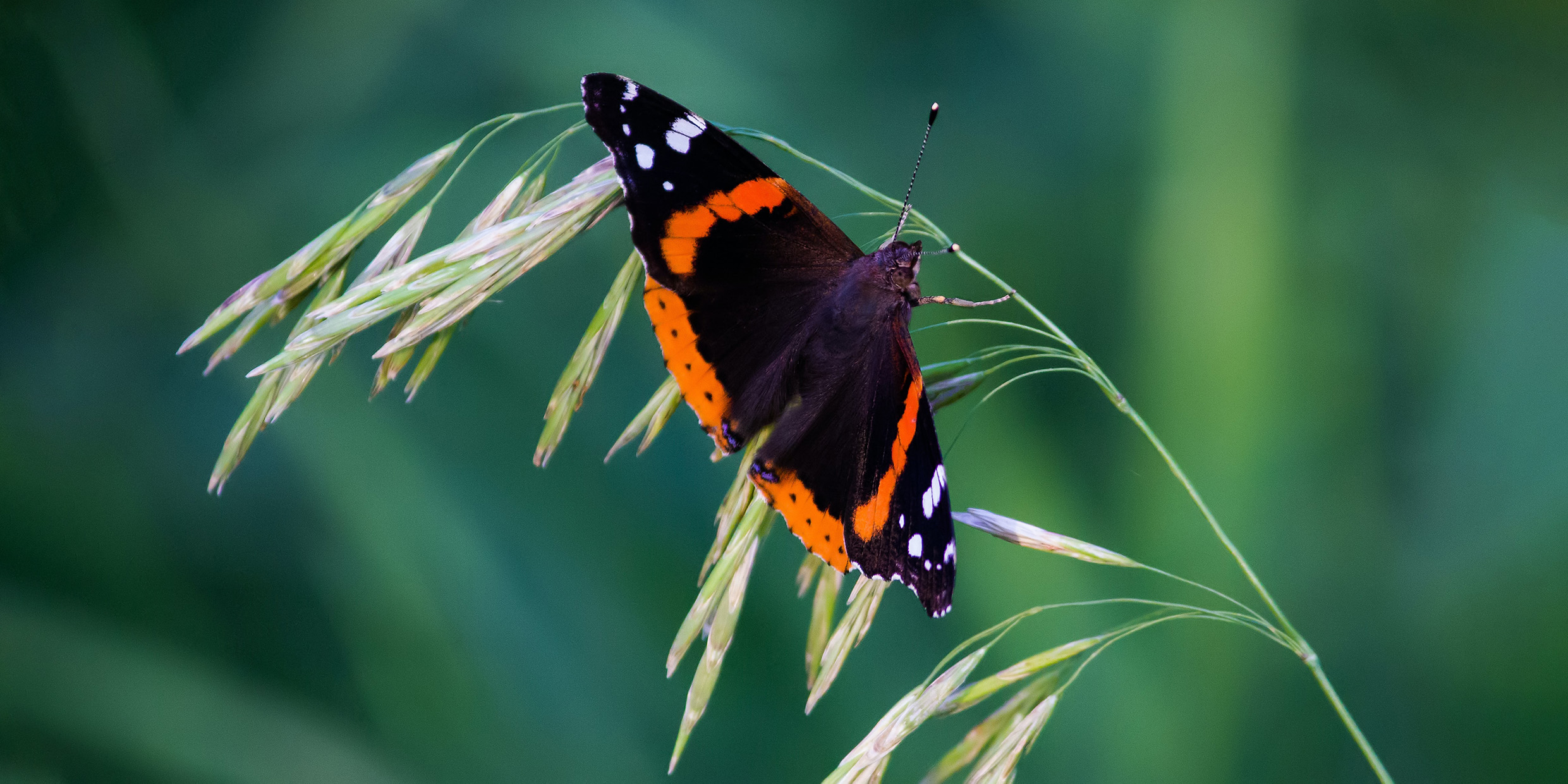Originally published 7 September 1992
On vacation recently, I was walking along a bog road in the hills of western Ireland. It was 8:30 a.m., the grass wet with dew, the sun burning off the last morning mists. I was accompanied by a dozen red admiral butterflies, fluttering from grass tuft to grass tuft a few yards ahead, pausing now and then to spread their showy black, white, and flame-orange wings, soaking up sunlight, drying out, adjusting their thermostats.
The red admiral is a species of butterfly every amateur lepidopterist will recognize. Big, colorful, and kerchief-conspicuous, it migrates to all parts of Britain and Ireland from its winter home in central or southern Europe. After a summer-long frolic in northern heaths and gardens, feeding and breeding, it flies back south. It is difficult to imagine how these mere slips of bright tissue — these origami insects — manage to flap their way from Spain, say, to an Irish bog. What impulse drives them north? What possible evolutionary advantage do they gain which would impel them on that long journey, impeded by broad sea crossings and summer gales?
As I walked and watched and wondered, I understood better than ever before the impulse that drives butterfly hunters in search of their quarry. Perhaps nowhere else in the world has butterfly collecting been pursued longer and more passionately than in Britain and Ireland. One might even say that amateur butterfly collecting is a British disease.
What’s the attraction?
First, there is beauty. Birds and beetles are beautiful too, but the apparent fragility of butterflies somehow makes them uniquely attractive.
Then, there is the diversity of the life cycle — from egg, to caterpillar, to chrysalis, to adult. Surely, no miracle of nature is more intriguing than the transformation that occurs in the chrysalis, when a creepy-crawly caterpillar curls up in a self-made sack and rearranges its molecules to emerge as a winged beauty.
There is also the manageability of collecting. Sixty species of butterflies currently breed in Britain, including three non-permanent residents — such as the red admiral — that arrive each spring, enough species to occupy a collector for many seasons, but not so many as to preclude the promise of a complete collection. By contrast, more than 4,000 species of beetles live in the British Isles, an impossible number for the amateur coleopterist to hope to embrace. Birds occur in more manageable numbers, but they are less suitable for keeping in cabinets, and the British like to permanently possess the things they collect.
Neither beetles nor birds possess the romantic names of butterflies. Duke of Burgundy, purple emperor, painted lady, peacock, comma, queen of Spain rritillary, Camberwell beauty: the mere idea of glimpsing such elegantly named creatures is enough to send one scampering into meadows.
Butterfly collectors are always alert to the possibility of capturing a rare visitor from abroad. In Ireland, one of the rarest and most prized visitors is the American monarch. About 400 specimens have been recorded in the British Isles, mostly within the past 50 years. Monarchs are prodigious flyers. Our New England monarchs migrate back and forth from one or two isolated sites in Mexico, a feat that fairly boggles the imagination. Most of the Monarchs sighted in Ireland are believed to be strays from these epic north-south migrations, blown willy-nilly across the Atlantic in years of strong easterly winds.
Not long ago, I stayed at a country-house hotel in County Cork, an old Anglo-Irish estate. A framed collection in the bar included specimens of all butterflies that live in Ireland, about 30 species. I would guess that few Anglo-Irish country houses of the last century did not have such a collection on display, probably prepared by a member of the household. Of course, not all 30 species were resident at any one locality, but friends and relations in other parts of the country could be counted on to share suitable specimens. In Victorian times, commerce in butterflies was ubiquitous.
These days, many species of butterflies are in decline, and conservation groups discourage frivolous collecting. The Victorian notion of nature’s inexhaustibility has given way to cautious preservation. Many British and Irish species of butterflies now depend entirely upon conservation groups to ensure their survival. For example, the brown hairstreak and the pearl-bordered fritillary can be found only in the beautiful limestone Burren region of County Clare, an area under increasing pressure of tourism. The link between these insects and the plants they breed upon has been refined by eons of evolution. Unless suitable breeding areas are maintained, certain species of butterflies are doomed to extinction.
Thoughtful non-professional lepidopterists are now content to collect with camera or watercolor brush. My own introduction to butterfly collecting was short-lived. Many years ago, I netted a magnificent specimen of monarch and put him into the killing bottle. The agony of watching that splendid creature die put a quick end to my collecting. Far better to walk though a highland bog escorted by a fluttering brood of red admirals — insects alive with the very essence of life, spectacular in their continent-spanning freedom.



